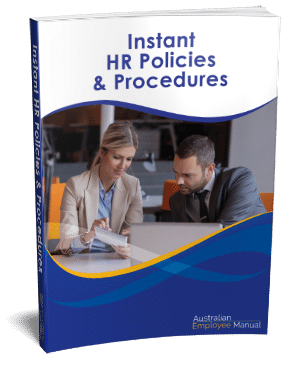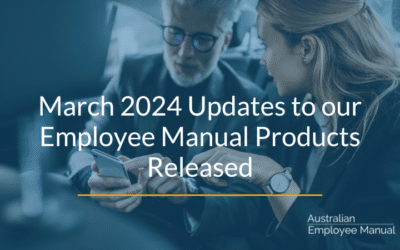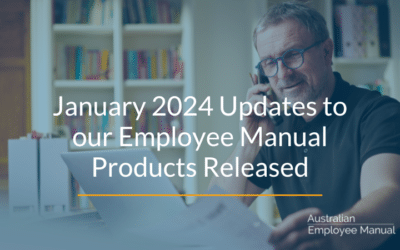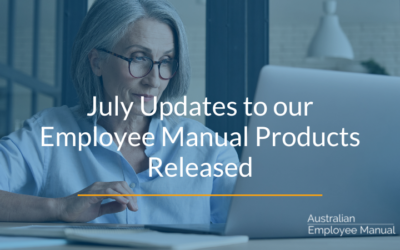How should a company that has never had an employee manual implement its new Employee Handbook with its team?
Employee policy and procedure manuals should not exist in isolation. Implementing an employee manual is as important as the words on the page and needs dedicated time and resources to make it happen.
If you have documented procedures but don’t follow them or take action inconsistent with your policies, you may end up on the wrong side of a case before the Fair Work Commission.
If you have never had an employee handbook, adding a new employee manual will be a cultural shift for your team.
Train Your Managers First
Once you have written your new policies, you must communicate them effectively to your employees.
Start with training your managers first on their roles and responsibilities. Ensure each manager has access to a copy to read through and discuss with you.
Talk them through your new manual in-depth, ensuring they understand why your business is implementing a formal policies and procedures manual.
Your managers will want input into how the procedures work in their area. For example, when someone is sick, should they ring Mary at the front desk by 8 am or text their manager by 7 am?
Managers may want to edit the words of the manual to better match their understanding of the internal operating processes of your company. Allow that editing process if you can, but retain the final approval of the changes.
A Quick Word For Managers
If you want your team members to follow procedures, you need to model this in your everyday actions.
For example, if you have a checklist to follow during a new employee induction and choose to skip significant steps of the process without explanation, you have just told your new employee that following the process is an optional extra in your business which will create problems for you down the track.
Communicate With Your Employees
Once your managers are trained, schedule a meeting with your employees to introduce the new employee manual.
You want this meeting to be similar to a new induction, where you draw a line in the sand about how your business does things around here now.
We recommend handing all attendees printed copies of your new Induction Manual. This will allow them to review the information and serve as a reference when needed.
The most important area to cover is the Code of Conduct, as this is the foundation policy upon which every other policy is based.
Ask each employee to sign a receipt indicating that they have received the new Induction Manual and that they understand its contents.
Keep a copy of this signed receipt on their employee file as evidence that they have been informed of the essential policies and procedures outlined in the Induction manual.
During the meeting, provide an overview of the full employee manual’s contents and how it applies to their jobs.
Highlight any significant changes from the previous processes in your workplace.
Also, ensure you let employees know how to access the full version of the manual and how you will notify them when policies are updated.
Encourage employees to ask questions and provide feedback on the new employee manual. Ask for suggestions on how to improve the manual’s contents or formatting. This will help ensure the manual is up-to-date and relevant to your workplace.
Given the complexity of some of the policies, you may want to schedule regular training or toolbox talks throughout the year on different policies and procedures.
Incorporate into Induction/Onboarding
Incorporate the new employee manual into your onboarding process for new employees. This will ensure new hires know your company’s policies and procedures from day one.
If you want compliance – model compliance.
Storing Your Employee Handbook
How you store your new employee handbook depends on your business. But the harder you make someone search for the information, the less likely they will follow it.
With many in your workforce now working remotely, you need to have your policies in an easily accessible place.
For small companies where team members work from the same office, the old-fashioned printed copies in a binder in the tea room work well.
Once you start getting over 50 employees, you need to look at company intranets and electronic copies of your procedures to ensure they are easily accessible by all your team members.
Many small businesses choose to put their employee handbooks into a shared Dropbox or OneDrive folder and give their employees read-only access to the files. (If you forget to make the files read-only, you can guarantee that a smart employee will assist by editing your policies to suit their needs.)
Should you separate your policies into individual policies or one big document?
Many businesses choose to store individual policies or procedures as standalone electronic documents. This works well if you only have a few policies and procedures (i.e. less than 20).
With most small businesses, the number of needed policies makes remembering or locating individual policies impossible, and makes scrolling long lists of links challenging.
Options can include putting them into a content management system with searching capability, having one master index with the individual documents linked from the index, or having one master document with everything included and a detailed index.
Integrating Procedures Into Everyday
If you specify specific steps you want people to follow in a policy or procedure, convert this into a checklist built into any electronic task management or workflow system you use or print off a hard copy if you are not using an electronic system. The more you make it easy for people to follow the steps, the higher your compliance rate will be.
Read more tips on how to write workplace policies and procedures.
Establish a Review Process
Your employee manual should be a living document that is updated regularly. Policies and procedures must be regularly reviewed for currency, legal compliance and alignment with your business direction.
Establish a review process that ensures the employee handbook is regularly reviewed and updated. This could involve setting a regular review schedule, such as every six months or annually, and involving key stakeholders in the review process.
At least once a year, read through every HR policy or procedure to make sure that the processes are still current, there have been no legislative or other changes that need to occur, that roles identified within the policy still exist, that any links within the document are current and that the policies and procedures still support your organisation’s values and direction. (It pays to check out sites such as the Fair Work Ombudsman for legislative changes).
Version control
Implementing version control for your employee handbook is essential to ensure all employees can access the latest document version as things are updated.
This could include numbering each version, using dates, or combining both.
The simplest way to keep your document current for all employees is to provide it as an electronic version in a shared drive or intranet.
If you decide to keep your policies paper-based, keep version control as simple as possible with a note in the header or footer of the new version date and/or number, and reissue a whole section rather than trying to fiddle with single-page removals.
Whatever method of version control you choose, create a master copy of the employee handbook that contains all policies and procedures.
This copy should be stored in a secure location accessible only to the business owner or the person responsible for maintaining the manual.
This master copy needs to also include notes of every change and the dates these changes were made to the manual.
Remember to communicate any changes to the employee handbook to all employees through an email or a meeting.
Implementing a new employee manual with your team requires careful planning and communication. By following these tips, you can ensure that your team knows your company’s policies and procedures and is equipped to perform their jobs effectively.




